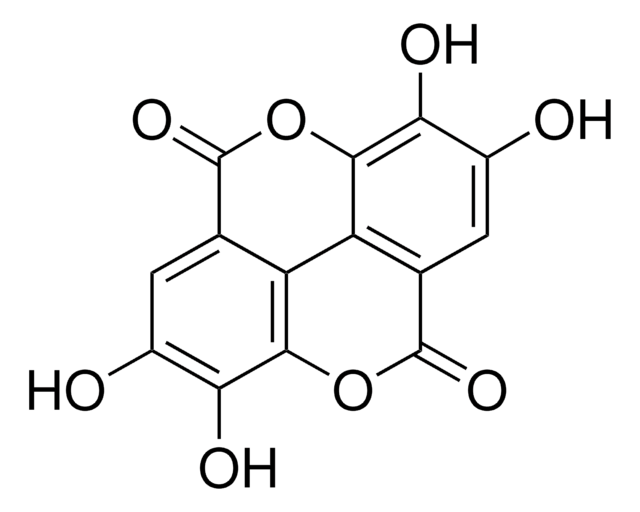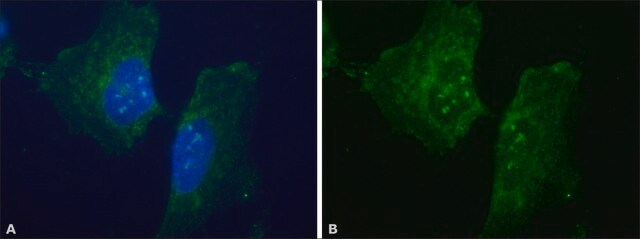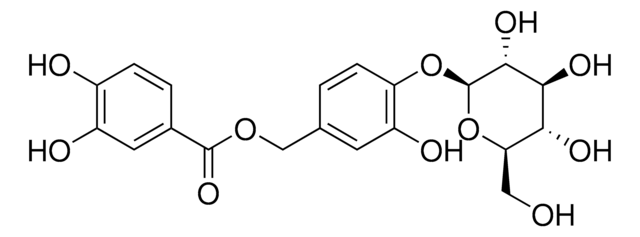推荐产品
生物源
rabbit
品質等級
共軛
unconjugated
抗體表格
affinity isolated antibody
抗體產品種類
primary antibodies
無性繁殖
polyclonal
形狀
buffered aqueous glycerol solution
物種活性
rat, human, mouse
技術
western blot: 1:1000 using using 293T kidney cells transiently transfected with human c-Met and stimulated with HGF
UniProt登錄號
運輸包裝
wet ice
儲存溫度
−20°C
目標翻譯後修改
phosphorylation (pTyr1230/pTyr1234/pTyr1235)
基因資訊
human ... MET(4233)
mouse ... Met(17295)
rat ... Met(24553)
一般說明
MET, a gene for receptor tyrosine kinase, was first isolated in human osteosarcoma-derived cell line. Hepatocyte growth factor (HGF) has been identified as the natural ligand for the c-Met receptor protein. HGF-induced c-Met activation is tightly regulated in the cells. Activation of the c-Met receptor results in binding and/or phosphorylation of many intracellular signaling proteins including multiple adaptor proteins (e.g., Grb2, Shc, Cbl, Crk, cortactin, paxillin, and GAB1) and a variety of other signal transducers (e.g., PI 3-kinase, FAK, Src, ERK1, JNK1, PLCa, and STAT3). HGF/Met signalling is actively responsible stimulating tumor angiogenesis, tumor growth, hypoxia and metastasis. Met overexpression through persistent ligand stimulation has been reported in many epithelial and mesenchymal cancers. Overexpression of Met enables metastasis in lung cancers, mutations in MET gene sequence have been reported in papillary renal cell carcinoma, lung cancers, ovarian, prostate, cervical, gastric and head and neck cancers. Anti-phospho-c-Met recognises human and mouse c-Met phosphorylated on Tyr1230, Tyr1234 and Try1235. Cross reaction with rat is expected due to 100% homology.
免疫原
synthetic phosphopeptide derived from the region of c-Met that contains tyrosines 1230, 1234 and 1235.
應用
Detection of phospho-c-Met by immunoblotting may be performed by using a working concentration of 0.11.0 μg/mL in 293T kidney cells, SP-1 mouse myeloma cells stimulated with HGF and A431 cells stimulated with EGF.
外觀
Solution in Dulbecco′s phosphate buffered saline (without Mg2+ and Ca2+), pH 7.3, with 50% glycerol, 1.0 mg/mL BSA (IgG and protease free) and 0.05% sodium azide.
免責聲明
Unless otherwise stated in our catalog or other company documentation accompanying the product(s), our products are intended for research use only and are not to be used for any other purpose, which includes but is not limited to, unauthorized commercial uses, in vitro diagnostic uses, ex vivo or in vivo therapeutic uses or any type of consumption or application to humans or animals.
未找到合适的产品?
试试我们的产品选型工具.
儲存類別代碼
10 - Combustible liquids
水污染物質分類(WGK)
WGK 3
閃點(°F)
Not applicable
閃點(°C)
Not applicable
個人防護裝備
Eyeshields, Gloves, multi-purpose combination respirator cartridge (US)
Joseph Paul Eder et al.
Clinical cancer research : an official journal of the American Association for Cancer Research, 15(7), 2207-2214 (2009-03-26)
A wide variety of human malignancies exhibit sustained c-Met stimulation, overexpression, or mutation, including carcinomas of the breast, liver, lung, ovary, kidney, and thyroid. Notably, activating mutations in c-Met have been positively identified in patients with a particular hereditary form
K A Furge et al.
Oncogene, 19(49), 5582-5589 (2000-12-15)
The Met receptor tyrosine kinase is the prototypic member of a small subfamily of growth factor receptors that when activated induce mitogenic, motogenic, and morphogenic cellular responses. The ligand for Met is hepatocyte growth factor/scatter factor (HGF/SF) and while normal
Fabiola Cecchi et al.
European journal of cancer (Oxford, England : 1990), 46(7), 1260-1270 (2010-03-23)
Under normal conditions, hepatocyte growth factor (HGF)-induced Met tyrosine kinase (TK) activation is tightly regulated by paracrine ligand delivery, ligand activation at the target cell surface, and ligand activated receptor internalisation and degradation. Despite these controls, HGF/Met signalling contributes to
S Fan et al.
Molecular and cellular biology, 21(15), 4968-4984 (2001-07-05)
Hepatocyte growth factor (scatter factor) (HGF/SF) is a pleiotrophic mediator of epithelial cell motility, morphogenesis, angiogenesis, and tumorigenesis. HGF/SF protects cells against DNA damage by a pathway from its receptor c-Met to phosphatidylinositol 3-kinase (PI3K) to c-Akt, resulting in enhanced
P Longati et al.
Current drug targets, 2(1), 41-55 (2001-07-24)
Control of cell growth and differentiation occurs via extracellular signals known as growth factors. Growth factors are high affinity ligands for transmembrane receptors belonging to the family of receptor tyrosine kinases (RTKs). A number of genetic evidences have implicated RTKs
我们的科学家团队拥有各种研究领域经验,包括生命科学、材料科学、化学合成、色谱、分析及许多其他领域.
联系技术服务部门






